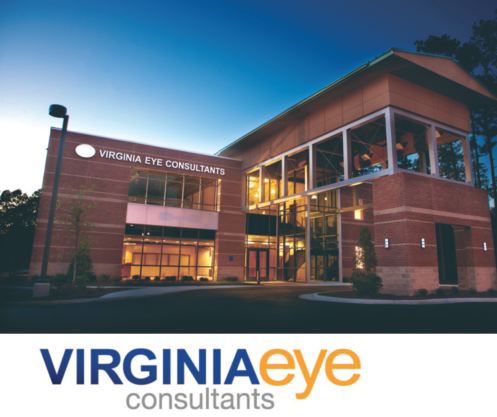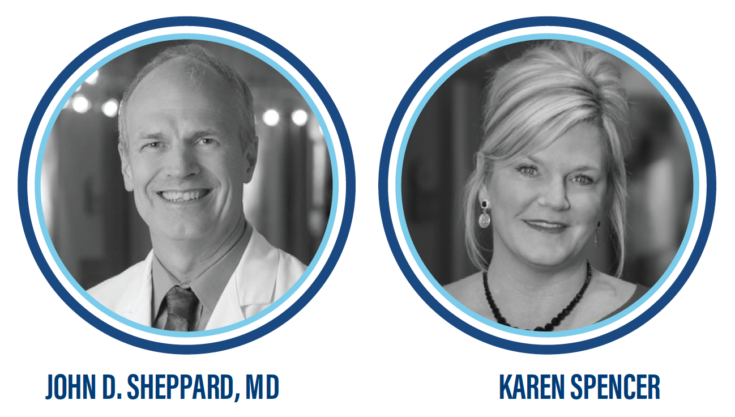
If Virginia Eye Consultants (VEC) were a tree, it would be an oak, with its strong, deep roots reaching throughout Southeastern Virginia, Northeastern North Carolina, and the Hampton Roads communities where it has been serving patients since 1963. Today, VEC is a continually growing 19-provider practice that has branched out to five clinic locations, an ophthalmic ambulatory surgery center, a dedicated centralized business hub, and a busy clinical research division.
VEC’s practice model is unique to its region. The large multispecialty ophthalmic referral center functions like an academic medical school-based practice and therefore does not provide primary eye care; it focuses on secondary/tertiary medical and surgical eye care and partners with approximately 150 community-based optometrists in what has become a nationally recognized optometric referral network. “We have all the ophthalmic subspecialties, and we provide basically one-stop shopping for all nonprimary eye care requirements,” explains John D. Sheppard, MD, president and founder of VEC and professor of ophthalmology at Eastern Virginia Medical School. “We send the primary eye care—annual exams, refractions, glasses, and contacts—to our network optometrists, and they refer surgery consults to us. We are the only practice in our region with this model.”

STEADY GROWTH
VEC is growing at 10% per year, and in response, two new doctors or surgeons are added to the fold annually. “Most recently, we hired a new cornea specialist and a new retina specialist, because both of those clinics are very busy and rapidly growing,” says Dr. Sheppard. He adds that a particular attitude is a prerequisite for all new VEC physicians across the specialties. “It’s essential to find people who share our philosophy of providing the very best in subspecialty referral care and who enjoy clinical research to help discover the merits of new ways to treat, or cure, eye diseases,” he remarks.
This mindset is sought after in nonclinical personnel as well, and it is reflected in the practice’s CEO, Karen Spencer. “Our practice really began to grow rapidly with the addition of Ms. Spencer, who joined us almost 9 years ago,” says Dr. Sheppard. “She brought the administrative expertise necessary to really take our entire group to the next level. While we had all the makings of something special, we didn’t really have anyone to guide the business ship. We needed our physicians practicing medicine, and with Ms. Spencer’s leadership, we were able to accomplish just that. When she arrived, we were struggling fiscally and had ambitiously built a new state-of-the-art facility. Since then, we’ve added three new satellite locations and renovated several of our existing facilities, and we are thriving.”
PIONEER IN THE INDUSTRY
Ms. Spencer, who honed her skills as a medical practice CEO for 25 years at various nonophthalmic enterprises prior to joining VEC, says the comanagement model is the core of VEC’s practice model and the basis from which a significant percentage of its revenue flows. She also points out that VEC has been a pioneer in the industry with new technologies, therapies, and procedures and that these initiatives have put the practice ahead of its competition, second only to its primary focus on best-in-class surgical outcomes. For example, VEC was the thirteenth practice in the United States to get the LenSx Laser (Alcon). “We were definitely pioneers in that arena, which has revolutionized the industry, and we certainly have been leaders in the field of new lens technology,” she maintains. “VEC tends to be first—if not in the state, then at least within the region.”
The future is wide open for this market leader. Dr. Sheppard explains, “In addition to bringing in two new providers this summer, we are also working on a build-to-suit facility in one of our satellite locations that will allow for us to expand our services and availability in that area, and it is set to open in January 2018.”
Here, Dr. Sheppard and Ms. Spencer provide additional insight into what makes VEC a market leader to watch.

CRST: Is there anything unique about VEC’s location that affects the practice?
Ms. Spencer: Something unique about our area is that Southeastern Virginia is at the mouth of the Chesapeake Bay. Our cities are connected by a series of bridges and tunnels, making it very important for us to have satellite locations where our patients live so it is convenient for them to get to us. There seems to be a psychological as well as a physical barrier to “going across the bridge” or “through a tunnel” to get to care. We are also in a coastal area that is home to the world’s largest naval base. As a result, we have the good fortune of a very stable economy fed by the military and federal contracts, not to mention the port, the beach, and historical tourism. This lends to our ability to recruit quality talent. The retiring military and federal workers who stay in the area due to all it provides also make the demographic of our region a very strong one for our specialty.
RITZ-CARLTON LEADERSHIP
When CEO Karen Spencer arrived at Virginia Eye Consultants (VEC), she recalls that it did not take long to see that “weed pulling” and “staff rebuilding” were a priority. She and VEC Vice President Stephen V. Scoper, MD, set out to develop a plan to “rebuild what is now our very strong work culture,” says Ms. Spencer.
The Ritz-Carlton Leadership Center was integral to implementing changes for the better. The Ritz-Carlton is known for its legendary customer and employee practices, and the Leadership Center helps clients across all industries, including health care, develop advantages in the marketplace based on those practices.
The Ritz-Carlton Leadership Center engages in four main service delivery lines. Advisory consulting services uses an eight-step consulting process to drive cultural transformation and has reportedly delivered double-digit improvement in customer satisfaction and loyalty. The three other key parts of the program include onsite presentations, enrichment courses, and customized learning services. For instance, an upcoming seminar “Best Practices for Service Excellence in Healthcare” suggests that, by exploring the award-winning business practices of The Ritz-Carlton, attendees can “discover how a service excellence culture results in a patient-centric environment, through engaged employees.”
Ms. Spencer explains that VEC engaged Ritz-Carlton Leadership Center to come into the practice for a weekend-long retreat to help retrain and inspire the entire staff, including providers and senior management. “We really took it seriously, and now the things we’ve learned are engrained in our daily practices,” she says. “We’re committed to continuing to embrace the Ritz-Carlton principles, and it’s a common thread throughout everything that we do.” For instance, every day at 9:30 am, all five locations throughout the organization have a 5-minute daily huddle. “It’s just a way to welcome the day and talk about any quick issues that everybody needs to know about that day,” she explains. “We have a quote of the day and a service value of the day, and the huddle captain rotates across the staff so everybody brings their own little flavor to it, and they tie that service value to something that affects them in their daily work. Finally, a short message about the Ritz-Carlton ‘tip of the day’ is offered. It’s a quick and easy way to remember that we’re all on the same team and that we’re dedicated to excellence, customer satisfaction, and customer loyalty.”
CRST: What values and practices enable VEC to thrive?
Dr. Sheppard: It is crucial to watch carefully and listen with intent to your team, to your patients, and to those with whom your practice interfaces. My motto is, “Patients first, employees second, referring providers third, and our doctors thrive.”.
Ms. Spencer: It is so important to skillfully utilize the talents of your people and all of the resources available to you. Place people in positions where they can be the most successful professionally and for the practice, but don’t be afraid to turn some loose into their future, either. Sometimes, letting go of your CAVE [consistently against virtually everything] employees can help retain those who will mean the most to your future successes.
CRST: Do you have some pearls for success to share?
Dr. Sheppard: Invest in a quality administrative leader. The right leadership can make all the difference in your practice. That physician-administrator dyad is truly synergistic and can be very powerful if paired correctly. Invest in providers second to none in clinical skills but with the right mindset and core values. Empower your colleagues and your employees to achieve their personal goals.
Ms. Spencer: Keep your fingers on the pulse of what is happening in the eye care industry, and in health care in general, and of course, within your market and your own four walls. Don’t be afraid to invest in training and morale building and recognition programs. Also, no matter the size of your practice, plan, plan, plan. It is key to plan strategy for the next 1 to 5 years. For a smaller practice, this might take the form of a simple meeting. For a larger practice, it may be more complex in the form of a weekend retreat led either internally or by a strong facilitator familiar with your practice.
CRST: Does VEC have strategies that help maintain its status as a market leader?
Ms. Spencer: Maintenance and growth of our referral center model are critical. We have also created an integrated network that will allow for further expansion of our services to the regional health systems and large primary care groups throughout the state. It is our goal to put ourselves at the table in collaborative relationships across the health care spectrum.
Dr. Sheppard: We have also continued to be leaders in innovation, research, and technology, which will only continue to enhance our service menu for our patients and assist in maintaining best-in-class surgical outcomes. We also enjoy and excel at teaching, with outstanding dedicated in-house optometry and ophthalmology training programs as well as a national and international presence on the podium.
CRST: What helps makes the practice excellent?
Ms. Spencer: Our practice prides itself on a rich culture of service, based on the principles of the Ritz Carlton (see Ritz-Carlton Leadership). We go to great lengths to immerse our team in the principles taught by the Ritz, which include providing world-class service to each other and to our patients. Each staff member takes pride in his or her work and knows [he or she has] the authority to do what it takes to make a patient’s day or make right a negative situation. Our team members are invested in the work that they perform and have input into our process and how our organization is run.
VIRGINIA EYE FOUNDATION
A little more than 15 years ago, John D. Sheppard, MD, president of Virginia Eye Consultants and professor of ophthalmology at Eastern Virginia Medical School, had the idea of a charitable organization dedicated to improving access to eye care for the needy and the prevention of blindness in Virginia, and from this, the Virginia Eye Foundation (VEF) was born. VEF raises funds to support medical and surgical care, education on and accessibility of eye care, and blindness prevention in Virginia, and it funds sight-saving surgeries and care for those without the ability to pay or without insurance. The organization also provides scholarships to high school seniors interested in pursuing a career in the visual sciences as well as grants to free clinics and organizations providing eye care services. “Part of the purpose was providing research, education, training, and patient care in the eye space for our region, and it’s been very successful,” says Dr. Sheppard.

Each year, the foundation provides support to underinsured patients throughout the community by assisting in sight-saving surgeries and care. Funds are also intermittently provided to clinics to provide eye care services for those in neighboring communities. “We’ve provided a lot of free care to patients in the area who—for whatever reasons—don’t have sufficient resources,” he says. “Many of these people are working, but even though they are employed, they can’t afford health care.”
The VEF Visual Sciences Scholarship Fund furthers the mission of the organization by providing scholarships to deserving and eligible students. Scholarships are awarded to two high school seniors each spring. “We’ve given college scholarships to a dozen youths who’ve had an eye care career in mind,” says Dr. Sheppard. “The scholarships we give are to needy people who haven’t had a lot of doors opened for them. It’s very gratifying to be able to help support their dreams.”
The foundation also supports continuing education of local health care professionals. Several workshops and seminars are offered throughout the year focusing on a variety of eye care topics, including new technology and procedures.
CRST: Was there a turning point when the practice’s brand crystalized?
Dr. Sheppard: This was truly an evolution over time. Nevertheless, our primary directive has always been providing world-class specialty eye care. We are not a practice that feels the necessity to overadvertise via radio/TV or otherwise. Our best referral sources are the doctors whom we train and with whom we network as well as patient word-of-mouth.
Ms. Spencer: Our referral network and our community involvement (see Virginia Eye Foundation) set us apart and have become our trademark. In addition, we have spent more dollars in web-based efforts to ensure our brand is well represented online through search and social media. We want to be easily accessible and well represented across all platforms.
CRST: What are some challenges that the practice has faced?
Ms. Spencer: During a very rapid growth phase, we had what I would call the perfect storm. We had opportunities present themselves that were too good to turn away, even though timing was not ideal. This led to some significant expansion investment in the practice several times over during a short period of time, creating significant expense. That investment, however, is starting to pay dividends, and in a few years, I am certain we will all safely say it was worth it.
CRST: Is there something about presiding over a practice such as VEC that a decade ago you would not have foreseen?
Dr. Sheppard: I think the big change is that we are so encumbered by both paperwork and computerization—documentation and regulations and extrinsic regulatory requirements. We have several grades of employees dedicated only to compliance. We are committed to the delivery of excellent patient care, and yet we have to relegate what feels like an endless array of resources to peripheral nonclinical concerns, which can certainly be frustrating.




